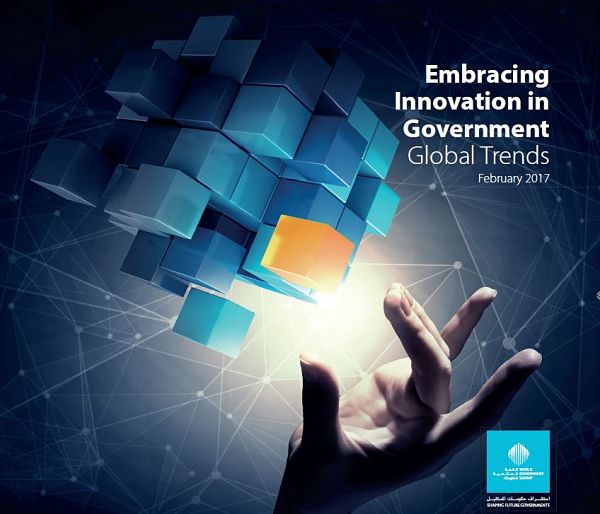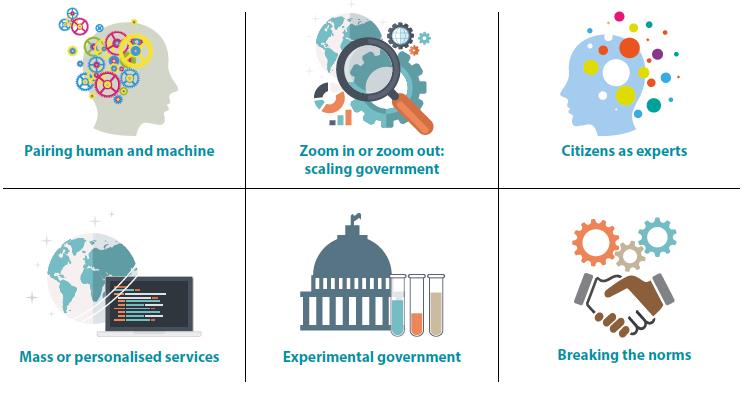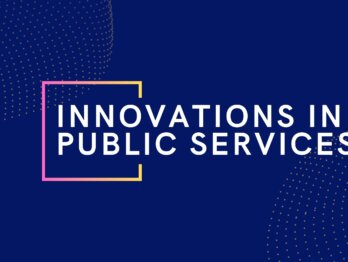Launched Today – Embracing Innovation in Government: Global Trends

Over the last year, we have been working in partnership with the UAE’s Mohammed Bin Rashid Centre for Government Innovation (MBRCGI) to conduct a global review of ways governments are transforming their operations and improving the lives of their people though innovation. We have conducted extensive research into innovation trends and examples in OECD member countries and non-members alike, as well as a two-month open “Call for Innovations” to identify examples of innovative practices in governments worldwide. Today, we are happy to issue the culmination of this work—Embracing Innovation in Government: Global Trends—at the World Government Summit in Dubai, the largest annual gathering in the world focused on shaping the future of governments through innovative practices. Read on for more details…
This morning at the start of the 2017 World Government Summit, OECD’s Director of Public Governance and Territorial Development (GOV) Rolf Alter launched Embracing Innovation in Government: Global Trends at the “Global Platform: Innovation and the Future of Governance” panel discussion. At this session, ministers from the UAE, Indonesia, Slovenia, and Portugal discussed the key findings of the report and steps governments can take to unlock the tremendous potential of innovation. We will follow up with another blog about the Global Platform and other World Government Summit events soon.
Over much of the last year, we have worked closely with our partners at the MBRCGI to conduct research on leading edge trends and examples in innovation. We have also analysed over 150 innovations, from 46 countries, that were submitted through our Call for Innovations to identify the latest developments in innovation on the ground today. Through this work, we have identified six key trends in public sector innovation. To show the real-life practical application of these trends, and the impacts they have, we selected ten innovation initiatives to profile as detailed case studies in the report.

Governments are balancing and augmenting the comparative advantages of human and machine approaches for solutions that exceed the abilities of each of these alone;
- PetaBencana.id (Jakarta, Indonesia) – a tool that combines data from hydraulic sensors with citizen reports over social media to produce real-time flood maps.
- Extreme Weather App (UAE) – an application that alerts citizens and government about current and future weather emergencies such as sandstorms.
Innovators are finding new ways to zoom in or zoom out to scale government services for more impact and to identify new solutions at a scale not previously possible;
- Mapatón (Mexico City, Mexico) – a crowdsourcing experiment to map the city’s previously uncharted bus routes through a smartphone game.
Initiatives are focusing on involving citizens as experts to provide new ideas and stimulate innovation among those most affected by its outcomes;
- Agents of Open Government (São Paulo, Brazil) – a learning initiative where private citizens with useful skills are given support to develop courses for government employees, civil society groups and communities in all corners of the city.
- Place to Experiment (Finland) – a digital platform for piloting, crowdfunding, and experimenting innovations initiated by citizens.
Governments are developing mass or personalised services that are user-centred, view citizens holistically, and recognise that individuals have unique wants and needs;
- The Wellbeing Project (Santa Monica, California, United States) – an initiative to combine the science of wellbeing with the power of data to design policies and services to help community residents thrive.
- Virtual Warsaw (Warsaw, Poland) – a virtual smart city that gives eyes to those who have trouble seeing though hundreds of thousands of bluetooth beacons.
Countries and cities are fostering the principles and cultures of experimental government to turn the public sector into a testbed for testing innovative ideas; and
- Blockchain Voting for Peace (Colombia) – a blockchain-backed voting process that gave Colombian expats to have their voices heard on whether to approve a historic peace treaty.
Public sector administrations and organisations are breaking the norms in the areas of government that manage human and financial resources, and which serve as the brains and lifeblood of public programmes.
- Spreading Innovation (Denmark) — a step-by-step guide and dialogue tool to help systematically replicate innovations in new contexts.
- 18F Micro-purchase Platform (United States) – an online auction system that leverages legal flexibilities to obtain open source software development to the lowest bidder through simple credit card transactions.
We spoke with the teams behind these innovations from all over the world. In these conversations, we discussed the challenges each faced, and how they overcame them through these innovative solutions. We heard about their lessons learned, as well as the impact and results the innovations have had on government and on the lives of citizens and residents. We also learned about how these innovations could be replicated by other countries and cities to help address common challenges. We’ve documented what we’ve learned in the Embracing Innovation in Government: Global Trends report to celebrate the work of these incredible teams, and to inspire innovators and catalyse innovation around the globe.
The heart of innovation is continuously striving for improvement and excellence. To help public sector leaders target their efforts and energy, we have identified four recommendations based on our work that public sector leaders can take action on to maximize the potential for innovation in their governments. These recommendations are:
- Signal innovation as a priority. Innovation is unlikely to take root in government unless senior leaders communicate that it is an important priority. This includes acknowledgement that sometimes failure is an acceptable outcome. This gives civil servants top cover to try new approaches and take calculated risks
- Enable connections across and beyond government. Civil servants should have at their disposal means of connecting with each other formally and informally, and for connecting with the public. Building cross-cutting networks and providing platforms for collaboration across organisations and sectors can help, as well as clear policy that ensures civil servants are empowered to reach across boundaries, including to the public.
- Promote trust through transparency and responsiveness. The trust of citizens is important. Without it, they are unlikely to cooperate with user-centred approaches or accept the outcomes of new policies and services. Governments can help build trust by being open about activities and decisions that affect people. However, transparency is not enough. Citizen input must be sought, considered, and acted on in visible ways.
- Forge partnerships with all relevant players. Government cannot do it all. Strategic and ongoing partnerships must be forged with civil society organisations, businesses, experts and the public. Each of these has unique strengths and competencies, and innovation in government accomplishes its biggest successes when all three come together. Civil servants must therefore have the ability to balance and interpret the sometimes competing priorities of these different groups, and be empowered to make decisions on how to proceed with what they learn.
The potential of innovation in government is immense. The challenges governments face in innovating is also significant. Despite this, governments are transforming the way they work to ensure this potential is met, as can be seen in the trends and case studies discussed in the report we launched today. You can download and read the report here.












